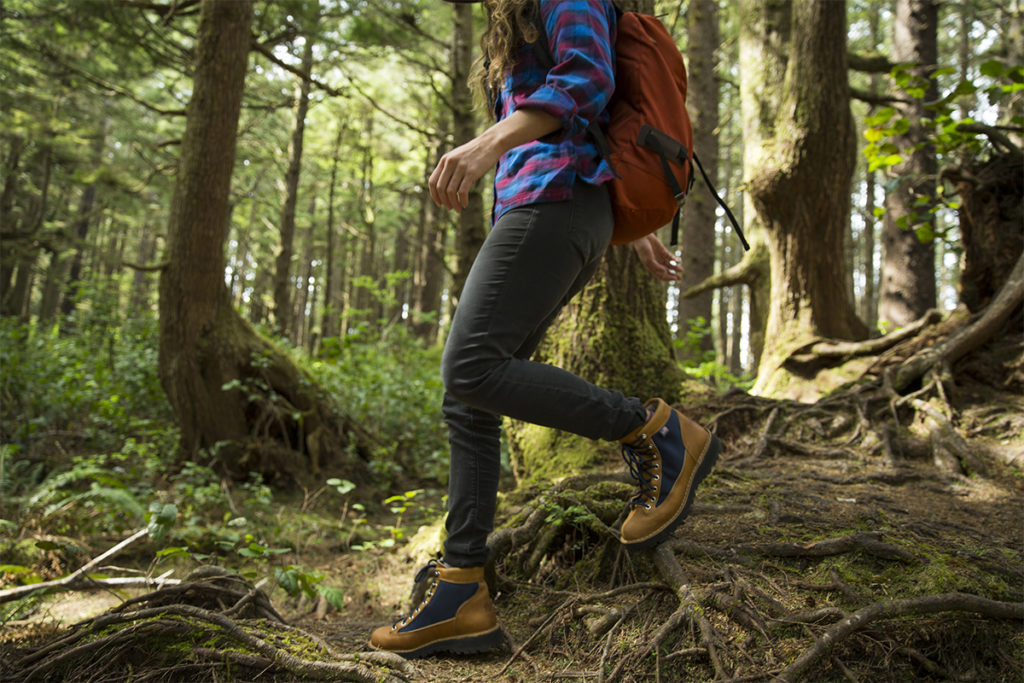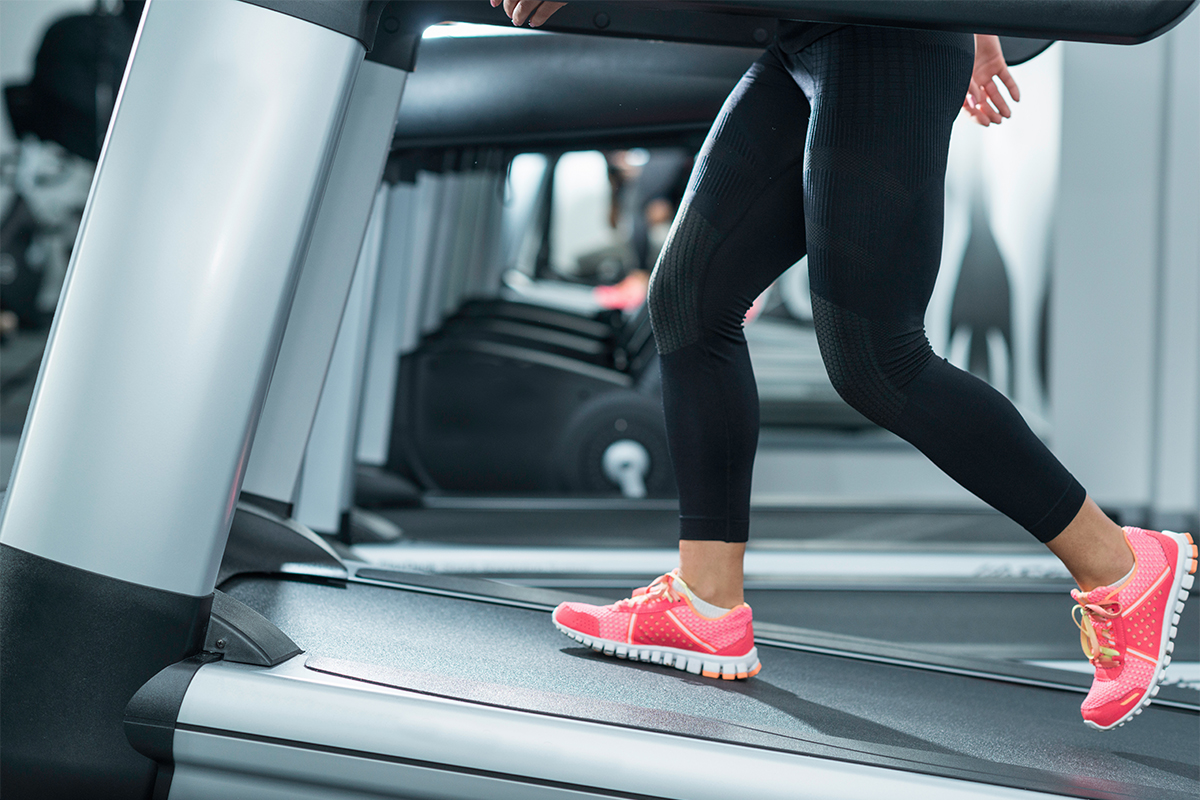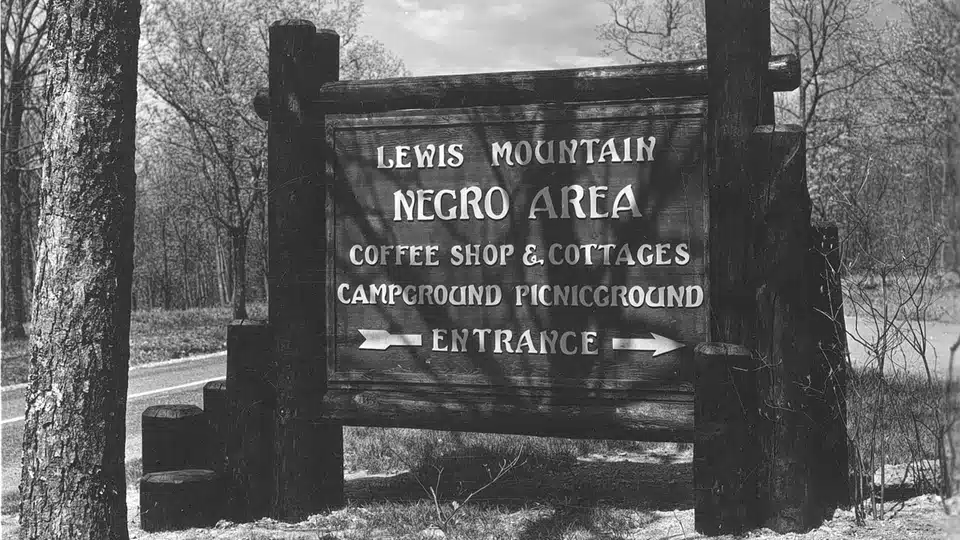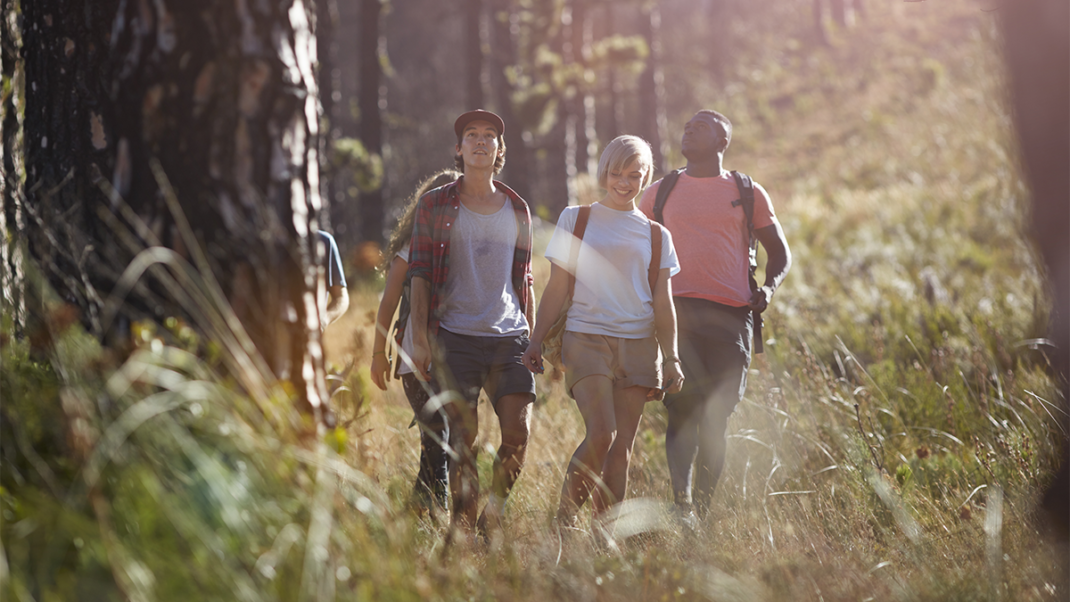Prepare Clients for the Hiking Trail
Design a program that highlights endurance.

During the lockdown, many people moved their fitness routines outside, and some chose to hit the trails. Hiking for exercise isn’t new, of course, but it’s likely that some clients picked up the healthy habit as a way to cope with quarantine restrictions, which often involved limited access to fitness facilities and in-person personal training. Numerous people, including some of your clients, may be hiking to keep active, and you can support them with a targeted program that takes into consideration the specific skills needed to progress to new heights while staying free from injury.
A Quick History of Hiking
The origins of recreational hiking date back to the 1830s. A disenfranchised French soldier named Claude-François Denecourt found solace in taking forest walks at Fontainebleau in France (Sciolino 2020). At that time, the tracks ran straight through the woods for carriages transporting people and goods, but Denecourt found hidden beauty while wandering among the trees. He took it upon himself to create trails through the wilderness to showcase its splendor. The forest at Fontainebleau set a precedent for future wilderness areas, including Yellowstone, the first national park in the United States, founded in 1872 (U.S. Department of the Interior 2019). The U.S. park system now consists of 421 park sites, and, in 2019, it received more than 327.5 million visits (Lower 2020; National Park Service 2020).
Park visitors have President Lyndon Johnson to thank for the extensive trail system we now enjoy. In 1965, he gave a closing address to Congress as part of a 2-day White House conference on natural beauty (LBJ Presidential Library 2007). “The forgotten outdoorsmen of today are those who like to walk, hike, ride horseback or bicycle,” he said. “For them we must have trails as well as highways.” He continued: “Old and young alike can participate. Our doctors recommend and encourage such activity for fitness and fun. I am requesting . . . a national system of trails, building up the more than hundred thousand miles of trails in our national forests and parks.”
Thanks to the National Trail System Act passed by Congress 3 years after this speech and amended by President Jimmy Carter in 1978, Americans now enjoy some 200,000 miles of trails on federal lands and more than 42,000 miles of trails within state-run parks (American Hiking Society 2015). In 2013, over 34 million Americans took advantage of the vast number of paths and went for a hike (American Hiking Society 2015). That number grew to nearly 48 million in 2018, making hiking one of the top five outdoor activities enjoyed in the U.S. (Statista 2020; McManus 2019).
Hiking Facts and Stats
Members of the American Hiking Society say they hike for exercise and to connect with nature (American Hiking Society 2015). Hiking is effective exercise, is inclusive and accessible to all, and requires little equipment, training or cost. Besides having physical benefits, hiking improves mental health by fostering a relationship with nature (Mitten 2016). Spending time among trees and the great outdoors reduces blood pressure, lowers cortisol and adrenaline levels, and amps up the immune system (Mitten 2016). Hiking has the added benefit of feeling more like play than exercise, which means people may enjoy it more than “formal” training.
While many consider hiking recreational, it is also an endurance sport. Like athletes who train for an event or a series of events, hikers may plan a targeted or scheduled hiking trip, such as a thru-hike or a section hike. A thru-hike is a trek from one end of a trail to the other. This type of excursion takes many months to complete, and hikers usually carry a backpack to camp along the way. Pathways amenable to thru-hikes include the Appalachian Trail and the Pacific Crest Trail, both in the U.S. Like thru-hikers, section hikers walk an entire trail. However, they do it in sections over a series of days, weeks, months or even years. They may or may not camp on the route. By contrast, day hikers embark on daylong treks that can stretch up to 20 miles.
While day hikes can be long and arduous, like climbing a 14er (a mountain with a summit higher than 14,000 feet), most American Hiking Society members participate in day hikes of less than 5 hours (American Hiking Society 2015). Usually, hikers find trails close to home and take advantage of what’s nearby before traveling afield. Therefore, if you live in an area near trails, many of your clients may already hike on a regular basis. Lest you think of hiking as a passing pandemic phase, a 2011 USDA Forest Service Recreation Trends study predicts that by 2060, day hiking will demonstrate the most growth in adult participation of all outdoor activities (American Hiking Society 2015). Now is the time to prepare your clients to be lifelong hikers!
See also: Happiness Is Found on the Hiking Trail
Training for Endurance

Backpackers and thru-hikers need an even greater endurance base, as they walk while carrying a load for up to 25 miles per day.
Endurance, defined as how long one can maintain a selected rate of work, is limited by fatigue when the body can no longer supply energy to the muscles (House, Johnston & Jornet 2019). When fatigued, hikers experience reductions in speed, power and function; they should, therefore, train like endurance athletes.
Theories abound concerning the origin of fatigue, but the heart’s pumping capacity is a known limiting factor to the delivery of oxygen and nutrients to muscles (House, Johnston & Jornet 2019). Luckily, the heart responds well to training. Progressive cardiovascular exercise improves cardiac output, which is the amount of oxygenated blood circulated with each heartbeat (House, Johnston & Jornet 2019).
However, cardiac training improves output (and endurance) only up to a point, depending on genetics. Training muscles to use delivered oxygen more efficiently further enhances endurance. This requires doing slow, steady cardiovascular activity to create the network of slow-twitch fibers needed to hike for 5 hours or more (House, Johnston & Jornet 2019). Backpackers and thru-hikers need an even greater endurance base, as they walk while carrying a load for up to 25 miles per day.
Researchers from the University of Rome conducted a study to determine how to plan an endurance training program that would simulate hiking conditions (Fattorini et al. 2012). They recruited 14 recreationally active young men to walk at several speeds on a level path while wearing boots and on a treadmill at various inclinations while wearing athletic shoes. The researchers measured participants’ walking energy expenditure (EE) and found that walking on a level, outdoor path wearing hiking boots required more energy than walking on a level treadmill in athletic shoes, no matter the speed (see “Lace Up Those Hiking Boots,” page 20, for more).
The scientists determined that to approximate the EE of hiking a level path while training on a treadmill, it would be necessary to increase the gradient by 3% (Fattorini et al. 2012). Additional scenarios were not analyzed in the study, but the authors support extrapolating the result to other hiking conditions. They suggest adding a 3% gradient to the grade of the goal hike to approximate the EE and desired effect when training on a treadmill.
Large amounts of low- to moderate-intensity training help hikers increase their aerobic capacity (House, Johnston & Jornet 2019). Suggested modes of cardiovascular exercise to meet this requirement include walking, slow jogging, cycling, and rowing or paddling. You can add high-intensity training, such as sprints and intervals, once hikers achieve a substantial cardio base, but avoid using HIIT unless a client’s aerobic capacity is well-established. Adaptations from high-intensity training happen quickly and can benefit hikers as they near the time for their desired trek.
What About Strength Training?
Even though hikers are endurance athletes, they need strength to climb and carry loads. Pelvic girdle strength is essential for unilateral leg stability and balance, for example; therefore, it’s important to assess hip and leg strength by evaluating a client’s knee stability. You can do this by using the following activity progression:
- body-weight squat
- box step-up
- modified pistol squat to a box
If the knee waivers and fails to track over the toes in any of these exercises, it’s a signal to stop and begin a progressive hip-strengthening program (see “Sample Workout for Hikers,” left).
Upper-body strength is also critical, since it supports the use of hiking poles and assists with balance and momentum. These exercises are suitable for assessing upper-body strength:
- overhand hang in a starting pullup position, shoulder blades retracted, 5 seconds or more
- assisted overhand pullup, 10 reps or more
- isometric overhand bar hang, in top pullup position, 5 seconds or longer
- overhand pullup, 10 reps or more
- incline pushup, 10 reps or more
- knee pushup, 10 reps or more
- full pushup, 10 reps or more.
If a client cannot keep the shoulder blades retracted with good form for the suggested number of reps, the next step is to program strengthening exercises at the appropriate level.
Hikers may underestimate the importance of core strength, which is critical for carrying backpacks and helping with balance. The core also transfers energy from the upper body to the lower body, making the arms swing and increasing the effectiveness of using hiking poles (House, Johnston & Jornet 2019). A weak or tired core “leaks” energy from the body while hiking.
You can gauge training needs for core strength with two simple activities:
- Assess core strength by having the client perform a timed forearm plank. If she cannot hold the position for 30 seconds, this signifies significant weakness. From 30 seconds to a minute demonstrates moderate strength, and longer than a minute means she is ready for more advanced activities.
- Test the obliques by having the client perform windshield wipers on her back with straight legs. The ability to perform fewer than 5 on each side with straight legs indicates oblique weakness and the need for strengthening (see “Sample Workout for Hikers,” left).
See also: No-Equipment Outdoor Workouts
Happy Trails
John Muir, “father of national parks” and noted environmental philosopher, is quoted as saying, “Of all the paths you take in life, make sure a few of them are dirt.” Help your clients prepare for their next chosen dirt path with a well-designed endurance program that also keeps in mind the supportive aspects of strength training.
Lace Up Those Hiking Boots
Because of its recreational aspects, hiking may not feel like a sport. However, hiking requires more energy and burns more calories than walking on level surfaces (Fattorini et al. 2012). While the uneven terrain contributes to the higher metabolic expenditure, hiking boots also play a role. On a treadmill, walking in boots requires 6% more oxygen than walking in athletic shoes (Fattorini et al. 2012). The muscles surrounding the knee also fatigue more quickly when people are walking in hiking boots (Fattorini et al. 2012). In a study of mountain visitors on holiday, researchers found that those who were less physically fit suffered more cardiovascular incidents than those who were fit.Therefore, improved cardiovascular fitness may be the most important training need for aspiring hikers.
Sample Workout for Hikers
Prep clients for day hikes, thru-hikes and more
Warmup:
Take the client through at least 15 minutes of dynamic, low-intensity cardiovascular activity.
Core:
- Plank: Begin at an appropriate level based on the assessment, and progress from 6 to 10 reps, 15 seconds to 2 minutes. Once the client can maintain good form for 2 minutes, progress to a more challenging stage.
- Windshield wipers: Progress from bent knees to straight knees, performing reps to failure for up to 6 sets.
- Seated Russian twists: Have the client start by holding a tennis ball and progress to carrying a heavy dumbbell or weighted ball. Perform up to 6 sets to failure.
Strength:
Perform 3 sets of the following circuit. Select an appropriate starting level for each move, based on the assessment.
Circuit:
- pushup, 15 reps
- leg-strengthening exercise, 15 reps per side (see examples, right)
- pullup, 15 reps
- leg-strengthening exercise, 15 reps per side
Leg strengthening:
Progress from body weight to weighted for 15 reps per side, choosing from these exercises:
- squat progression
- lateral leg lift in side lying position or standing with resistance band
- box step-up, step-down and lateral step-up
- lunges—front, back and side
- deadlift progression
- calf raises
References
American Hiking Society. 2015. Hiking trails in America: Pathways to prosperity. Accessed Aug. 18, 2020: americanhiking.org/wp-content/uploads/2015/05/AHS_RPT_fnl_LOW.pdf.
Fattorini, L., et al. 2012. Workload comparison between hiking and indoor physical activity. Journal of Strength and Conditioning Research, 26 (10), 2883-89.
House, S., Johnston, S., & Jornet, K. 2019. Training for the Uphill Athlete: A Manual for Mountain Runners and Ski Mountaineers. Ventura, CA: Patagonia.
LBJ Presidential Library. 2007. Special message to the Congress on Conservation and Restoration of Natural Beauty, February 18, 1965. Accessed Aug. 18, 2020: lbjlibrary.net/collections/selected-speeches/1965/02-08-1965.html.
Lower, R. 2020. How many national parks are there? National Park Foundation. Accessed Oct. 14, 2020: nationalparks.org/connect/blog/how-many-national-parks-are-there.
McManus, M. 2019. The ‘wild’ effect? Why hiking is surging in popularity in the U.S. Accessed Aug. 18, 2020: adventure.howstuffworks.com/outdoor-activities/hiking/wild-effect-hiking-surging.htm.
Mitten, D. et al. 2016. Hiking: A low-cost, accessible intervention to promote health benefits. American Journal of Lifestyle Medicine, 9, 12 (4), 302–10.
National Park Service. 2020. Annual visitation highlights. Accessed Oct. 14, 2020: nps.gov/subjects/socialscience/annual-visitation-highlights.htm.
Sciolino, E. 2020. The invention of hiking. Smithsonian Magazine. Accessed Aug. 30, 2020: smithsonianmag.com/travel/invention-hiking-1-180974592/.
Statista. 2020. Number of participants in hiking in the United States from 2006 to 2018 (in millions). Accessed Aug. 18, 2020: statista.com/statistics/191240/participants-in-hiking-in-the-us-since-2006/.
U.S. Department of the Interior. 2019. 7 things you didn’t know about Yellowstone National Park. Accessed Aug. 18, 2020: doi.gov/blog/7-things-you-didnt-know-about-yellowstone-national-park.





